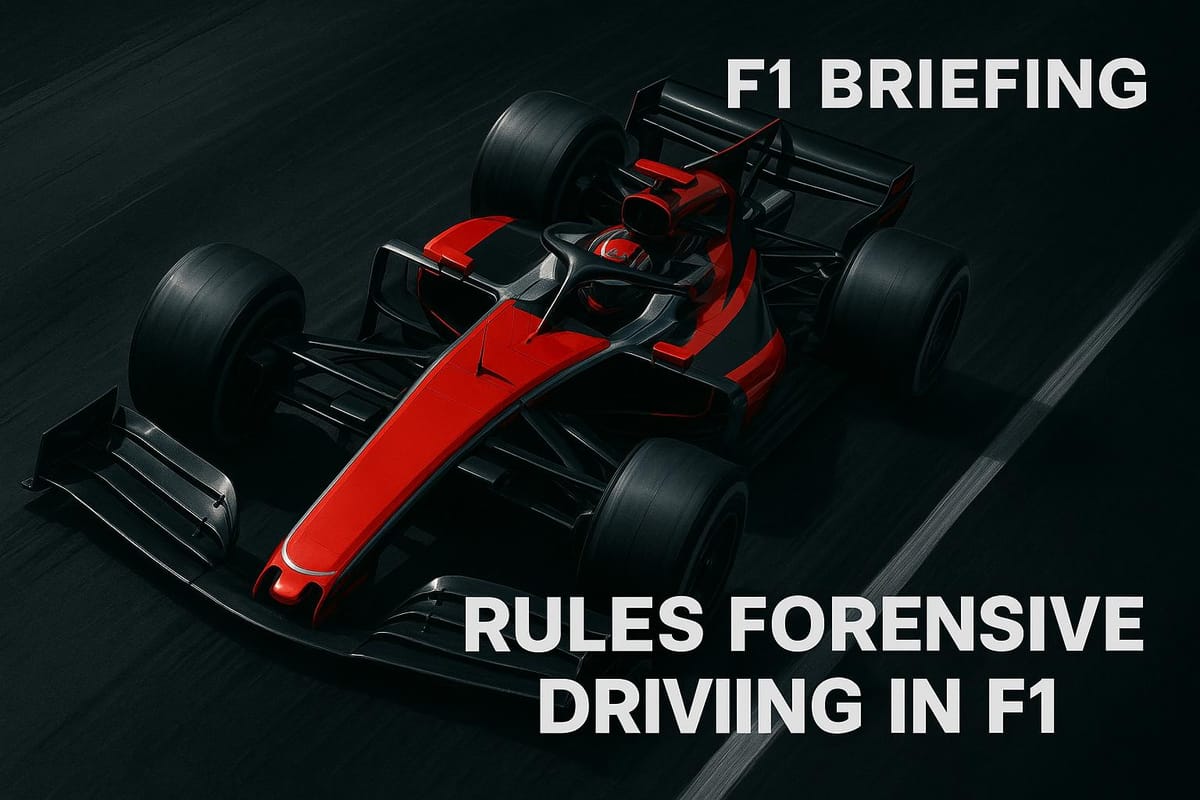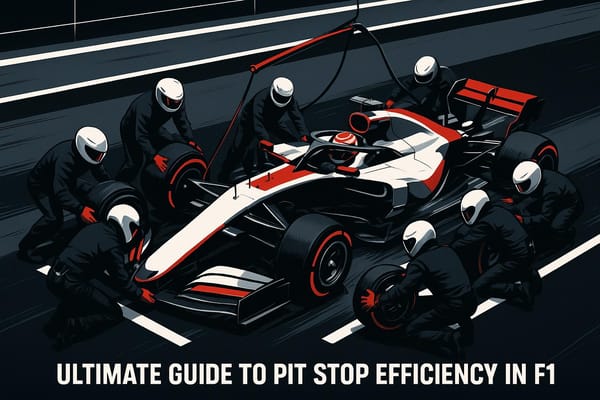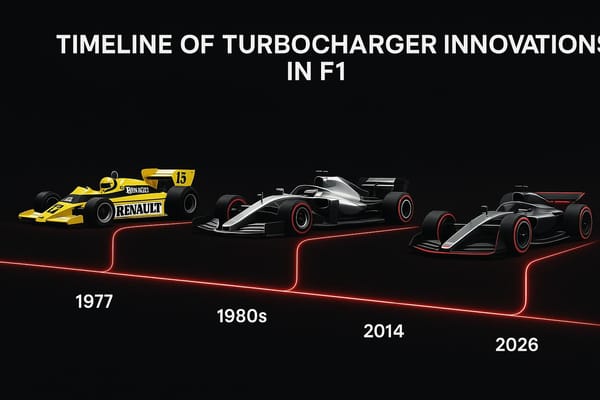Rules for Defensive Driving in F1
Explore the essential rules of defensive driving in Formula 1, ensuring safety and fairness while defending positions on the track.

Want to know how Formula 1 drivers defend their position without breaking the rules? Here's the key: F1's governing body, the FIA, has strict guidelines to ensure drivers can hold their ground while keeping races safe and fair. These rules cover everything from how many moves a driver can make to block an opponent, to what happens when they rejoin the track. Here's a quick breakdown of what you need to know:
- One Move Rule: Drivers can only make one direction change to defend their position. Any return to the racing line must leave at least one car width for the opponent.
- Track Limits: Drivers can't leave the track or force others off it during a battle.
- Prohibited Moves: Dangerous tactics like weaving, brake testing, or unsafe rejoining are not allowed.
- Room for Overtakes: Defenders must leave space if the attacking car meets specific positioning criteria at the apex.
The FIA enforces these rules to keep racing competitive yet predictable. Drivers who violate them risk penalties like time deductions or even race suspensions. To block effectively, drivers must focus on timing, positioning, and staying calm under pressure - all while respecting the rulebook.
The Art of Defensive Driving - Success and failure in overtaking in Baku
FIA Rules for Protecting Position

The FIA has laid out detailed regulations to ensure that defensive driving in motorsport remains competitive without compromising safety. Through its Driving Standards Guidelines, the FIA has established clear boundaries to balance aggressive racing with responsible behavior on the track.
One Move Rule
The One Move Rule is a cornerstone of the FIA's defensive driving regulations. It allows drivers to make only one change of direction when defending their position against a challenger.
"More than one change of direction to defend a position is not permitted. Any driver moving back towards the racing line, having earlier defended [their] position off-line, should leave at least one car width between [their] own car and the edge of the track on the approach to the corner."
Additionally, drivers are prohibited from making any directional changes during the braking phase unless they are following the natural racing line. This rule is crucial because drivers behind are often at their braking limits, leaving little room to react to sudden moves.
"When defending, there must be no change in direction by the defending car, after the deceleration phase has commenced, except to follow the racing line."
These measures are designed to ensure that defensive moves remain predictable, reducing the risk of collisions.
Track Limits and Car Positioning Rules
Track limits play a vital role in defining legal defensive maneuvers. Drivers returning to the racing line after defending must leave at least one car width between their car and the track edge. This ensures that overtaking opportunities remain viable and prevents defenders from completely blocking the path of an attacking car.
While drivers are allowed to use the full width of the track for their initial defensive move, they cannot exceed track boundaries or force their opponents off the circuit. These rules ensure that defensive tactics remain fair and within the spirit of competition.
Banned Maneuvers
The FIA has explicitly banned several dangerous or unsporting defensive actions to maintain safety and fairness on the track.
-
Deliberate crowding: Pushing another car off the track is strictly forbidden.
"However, manoeuvres liable to hinder other drivers, such as deliberate crowding of a car beyond the edge of the track or any other abnormal change of direction, are strictly prohibited."
- Brake testing: Abrupt deceleration by the defending driver to disrupt the attacking car's momentum is not allowed, as it can lead to rear-end collisions.
- Deliberate speed variations: Drivers are prohibited from making unpredictable speed changes, especially during safety car periods, as this can create a dangerous chain reaction through the field.
- Unsafe track rejoining: After running wide or making an error, drivers must rejoin the track safely without obstructing other cars. Defensive moves that involve cutting across the track after leaving it are not permitted.
These rules provide a structured framework that allows drivers to defend their positions assertively while prioritizing safety. By enforcing these standards, the FIA ensures that wheel-to-wheel battles can unfold at high speeds without unnecessary risks.
Common Rule Violations When Blocking
The FIA enforces strict rules to ensure defensive driving remains predictable, precise, and above all, safe. When drivers push these boundaries, penalties can follow, often altering race results. By understanding the most frequent infractions, we can better grasp how the FIA maintains a fair and competitive environment.
Unsafe Blocking or Weaving
One of the most common violations involves excessive directional changes, which breach the "one-move rule." This rule allows drivers to make a single change of direction to defend their position. However, under pressure, some drivers exceed this limit, particularly on straights where high speeds leave following drivers with little reaction time. These unpredictable moves not only heighten the risk of collisions but also disrupt fair competition.
When stewards identify such behavior, penalties often follow. These can range from time penalties to the accumulation of penalty points on a driver's Super License. Drivers who rack up 12 points within a 12-month period face a one-race suspension. Beyond weaving, other overly aggressive actions can also lead to scrutiny and sanctions.
Forcing Opponents Off Track
Deliberate crowding is another tactic that draws the FIA’s attention. This tactic gained significant focus after high-profile incidents, such as Max Verstappen forcing Lando Norris off track during the 2024 Mexico Grand Prix. The FIA explicitly prohibits this behavior to maintain fair racing conditions.
To clarify, the FIA's 2025 Driving Standards Guidelines outline when an overtaking driver must be given room. For inside overtakes, the attacking car’s front axle must be alongside the defender’s mirror at the apex. For outside overtakes, the overtaking car’s front axle must be ahead of the defender’s front axle at the apex. Once these conditions are met, it’s the defending driver’s responsibility to avoid contact or forcing the overtaking car off track.
The Brazil 2021 incident serves as another example, where a driver was penalized for forcing an opponent off track. Depending on the severity of such infractions, penalties can include time penalties, drive-through penalties, or other sanctions.
"If it has been established from points A and B below, that an overtaking driver has priority, it is the responsibility of the defending driver to avoid a collision or forcing off the overtaking driver."
Unsafe Track Rejoining
Rejoining the track unsafely after leaving it is another common issue. When a driver exits the track while defending, they must rejoin in a way that doesn’t endanger others. Cutting back across the racing line recklessly, especially when other cars are in the middle of overtaking maneuvers, is viewed as a serious offense.
Such actions compromise predictability, a key factor in maintaining safety. If a rejoining driver gains a lasting advantage, they are generally required to relinquish their position. However, if the rejoining maneuver endangers other competitors, stewards may impose harsher penalties, such as time penalties, stop-go penalties, or even grid penalties.
In modern F1, where high speeds and close racing are the norm, even non-contact violations are treated with great seriousness. As George Russell, Director of the Grand Prix Drivers' Association, explained:
"Greater transparency within the governance of our sport is an important issue and this is a useful step in that direction. Hopefully it will be beneficial for the sport to give the media and fans a clearer understanding of the rules of engagement when we're racing on track, and to help them understand how the stewards reach their decisions."
How to Block Without Getting Penalties
Defending your position on the track is an art that requires precision, strategy, and a deep understanding of the rules. By following FIA guidelines, drivers can execute effective defensive maneuvers without crossing the line into illegal territory. Success comes down to mastering timing, anticipating opponents' moves, and staying composed under pressure. Here's how to hold your ground while keeping penalties at bay.
Timing and Track Position
The FIA's "one-move rule" is the cornerstone of legal defensive driving. This rule allows defenders to make a single directional change to protect their position. If returning to the racing line after defending off-line, drivers must leave at least one car width between their vehicle and the track's edge when approaching a corner. This ensures safety and prevents dangerous situations like squeezing opponents into tight spaces.
Braking zones are another critical area where discipline is essential. Once a driver begins braking, any additional changes in direction - aside from following the natural racing line - are prohibited. Past incidents have shown how crucial it is to respect this rule to avoid penalties and ensure fair racing.
Positioning is also key when it comes to cornering. For an inside overtake, the attacking car must have its front tires at least alongside the defender's car by the apex to claim space. On the outside, the overtaking car needs to be ahead from the apex to secure the line. Understanding these dynamics allows defenders to place their cars strategically, making it harder for attackers to find an opening.
But positioning alone isn’t enough - drivers also need to anticipate their rivals' moves to stay ahead.
Reading Opponent Moves
Top-tier drivers excel at predicting what their opponents will do next. By studying driving patterns, car behavior, and positioning, defenders can foresee overtaking attempts and adjust their lines accordingly - without resorting to last-second, illegal reactions.
For instance, understanding speed differences is crucial. A well-timed defensive move can disrupt an attacker's slipstream advantage, provided it's done early enough to remain within the rules. Observing an opponent’s braking points and preferred corner entries also helps defenders choose the best legal counter-move.
Additionally, knowing how race stewards evaluate incidents - such as late braking, dive-bombing, or movement under braking - gives defenders an edge in ensuring their actions stay within the legal framework.
While technical and tactical skills are vital, maintaining mental composure is what truly sets great defenders apart.
Staying Calm Under Pressure
Defensive driving often happens under intense pressure, with faster cars looming in the mirrors. In these moments, staying calm is essential. Panic can lead to rash decisions, like making abrupt directional changes or rejoining the track unsafely - moves that are sure to draw penalties. Instead, successful defenders rely on techniques like controlled breathing to stay focused and execute their single, deliberate move.
Situational awareness is equally critical. Drivers must keep an eye on their mirrors, monitor track position, and stay mindful of braking markers - all while making split-second decisions. Communication with race engineers can also provide valuable insights, such as details about an opponent’s tire condition or strategy, which can inform defensive tactics.
Psychology plays a big role, too. Projecting confidence and maintaining predictable driving often discourages aggressive overtaking attempts. As George Russell explained:
"Greater transparency within the governance of our sport is an important issue and this is a useful step in that direction. Hopefully it will be beneficial for the sport to give the media and fans a clearer understanding of the rules of engagement when we're racing on track, and to help them understand how the stewards reach their decisions".
Ultimately, sticking to the basics - precise braking, smooth steering, and controlled throttle use - helps defenders maintain technical accuracy and avoid impulsive mistakes that could lead to penalties.
Best Methods for Legal Position Protection
Defensive driving in motorsport is about walking a fine line: staying aggressive enough to hold your ground while adhering to the FIA's strict regulations. The best defenders know how to maximize their position without stepping outside the rulebook. Here’s how to do it.
Balancing Hard Racing with Clean Driving
Defensive driving isn’t just about blocking; it’s about timing and precision. The smartest drivers make their defensive moves early, before the attacking car fully commits. This proactive approach disrupts the opponent’s rhythm and ensures compliance with the FIA’s one-move rule.
The FIA's overtaking guidelines are clear: positioning at critical moments determines who deserves racing room. Once you’ve initiated your defense, consistency is key. Stick to your line during braking - changing direction after deceleration begins is a no-go under FIA rules. This regulation is designed to prevent erratic, last-second moves that could lead to dangerous collisions.
"More than one change of direction to defend a position is not permitted. Any driver moving back towards the racing line, having earlier defended [their] position off-line, should leave at least one car width between [their] own car and the edge of the track on the approach to the corner".
The takeaway? Make your intentions clear. If you move off the racing line to defend, commit to it. And if you return to the racing line, leave at least one car width of space near the track edge as you approach the corner. From there, focus on using the track’s width to your advantage - legally, of course.
Using Track Width Legally
Maximizing track width can be a game-changer in defense, but it requires a sharp understanding of FIA regulations. According to the rules, the white lines marking the track edges are part of the track, but the kerbs are not. This distinction opens up opportunities for strategic positioning.
Here’s the trick: as long as a portion of your tire remains in contact with the white line, you’re still within track limits. Motor Sport Magazine explains:
"It's acceptable to have all four wheels mostly outside of the white line, as long as a sliver of the tyre remains on the white line".
This tactic is especially effective when defending on corner exits. By using every inch of legal track space, you make it harder for opponents to find a clean overtaking opportunity. It’s a simple yet powerful way to maintain momentum while keeping your rivals at bay.
Kerbs, while not part of the track for track-limit purposes, can also be used tactically. As long as you maintain that critical contact with the white line, strategic kerb usage can expand your defensive options. Just be mindful of the three-strike system for track-limit violations, as repeated infractions lead to escalating penalties.
Adjusting to Different Race Conditions
Defending effectively means staying adaptable. Tire wear, car performance, and even weather conditions can all influence your strategy. A well-timed adjustment can make the difference between holding your position and losing it.
Pay attention to your opponent’s habits. If they repeatedly attack in the same spots, tweak your positioning to counter their moves. Keep an eye on factors like tire strategy, fuel load, and any damage they might be dealing with - these clues can help you predict their next move.
Stewards evaluate defensive incidents by considering a range of factors, including late braking, car control, driver visibility, and corner type. Smart defenders account for these elements, adjusting their aggression based on the likelihood of intervention from race officials.
Finally, always consider the bigger picture. Championship standings, team strategies, and the remaining race distance all play a role in determining how hard you should fight. Sometimes, letting a faster car pass early can save you time and energy for the long run. Other times, holding your ground is the only option. By reading the race dynamics, you can defend effectively while staying within the FIA’s guidelines.
Conclusion
Mastering defensive driving in Formula 1 demands precision, impeccable timing, and a solid grasp of the sport’s regulations. These rules aren’t just there to maintain fair competition - they’re also critical for keeping drivers safe on the track.
At its core, legal defensive driving hinges on a few essential principles: making only one defensive move, respecting the space of opponents when they’re alongside, and avoiding unpredictable actions, especially during braking. Over time, incidents on track have prompted the FIA to refine its guidelines, creating clearer standards for drivers, stewards, and fans alike.
The art of effective defense isn’t about blocking at every turn - it’s about smart positioning. The best defenders anticipate moves early and adapt to the ever-changing dynamics of a race. Sometimes, letting a faster car pass can be the wiser choice, saving energy and avoiding potential penalties that could cost more in the long run.
For drivers aiming to sharpen their defensive strategies, studying past incidents and steward rulings can be invaluable. Teams dedicate significant resources to analyzing telemetry and race footage, helping drivers balance aggressive defense with clean, rule-abiding racing. These efforts highlight how thoughtful, regulated defense preserves both the competitive spirit and safety of Formula 1.
FAQs
What penalties can F1 drivers face for breaking defensive driving rules during a race?
F1 drivers risk facing time penalties, grid penalties, or penalty points on their superlicense if they violate defensive driving rules. In more severe situations, they could even be disqualified or suspended from a race.
Penalty points remain on a driver's superlicense for 12 months. If a driver collects enough points during that time, they might face stricter consequences, such as a race ban. The severity of the penalty is determined by how serious the rule violation is.
How does the FIA decide if a defensive move in F1 is unsafe or against the rules?
The FIA assesses defensive maneuvers in Formula 1 to ensure they comply with safety regulations and sporting rules. They focus on whether a driver’s actions, like sudden braking or abrupt swerving, could create dangerous situations or disrupt the race. Moves such as deliberately pushing another car off the track or excessive blocking also come under scrutiny.
Race stewards analyze incidents by reviewing video footage, telemetry data, and FIA guidelines to determine if a move was unsafe or went against the rules. If a violation is identified, drivers can face penalties such as time deductions, grid position drops, or penalty points. The overarching aim is to maintain fair competition while keeping safety a top priority on the track.
How do F1 drivers defend their position without breaking the rules?
F1 drivers hold their ground on the track by adhering to FIA regulations, which are crafted to promote both safety and fairness during races. These rules include prohibiting multiple direction changes, ensuring enough room is left for competitors during overtakes, and avoiding abrupt or erratic movements that might cause collisions.
To defend effectively, drivers focus on precise track positioning, particularly in corners, while maintaining full control to steer clear of unsafe actions. By sticking to these principles, they can safeguard their position and reduce the likelihood of penalties, such as time deductions or drive-through penalties, for improper maneuvers.




